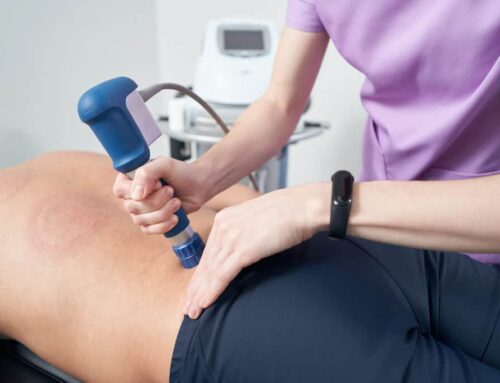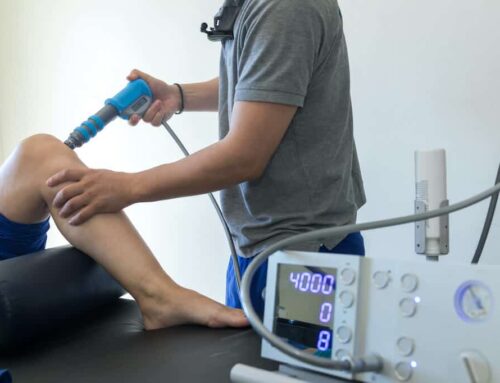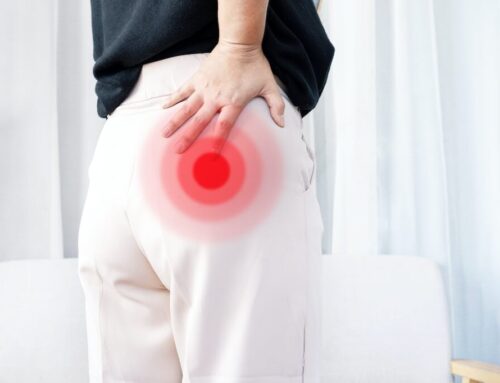
Stubborn hip pain can slow you down in everyday life and stop you from enjoying the things that matter most to you. As one of the most common causes of hip pain, hip bursitis is a challenging and often frustrating condition to live with.
But what if what you think is hip bursitis is actually something else? It can be hard to know exactly what’s causing your hip pain, and working with the wrong diagnosis can actually slow down your recovery in the long-term.
You shouldn’t have to miss out on important life events or lose your physical independence because of hip pain, and with the right diagnosis for your hip pain, you can get relief and make progress in your recovery faster.
In this article we’ll cover what hip bursitis is, what it’s commonly mistaken for, and how getting the right diagnosis can accelerate your recovery.
What is Hip Bursitis?
Hip bursitis is a term used to describe inflammation of one or more bursae in your hip. Bursae are thin, fluid-filled sacs that provide cushion around your joints and sensitive areas of your body. When these bursae become inflamed, they become sensitive to touch, pressure, and stretch, causing hip pain.
For many people, living with hip bursitis is difficult and frustrating. With sleepless nights, unpredictable pain, and feeling lousy due to inactivity, it can be hard to stay positive. Another major issue with hip bursitis is that common treatments, such as medication and hip injections, aren’t very appealing for most people because of their side effects and short-term benefits.
With hip bursitis, lying on your side can be very uncomfortable because it puts pressure on hip bursae, which can lead to discomfort in bed and sleepless nights. Other normal everyday movements, like walking up stairs, can also become incredibly painful because they use muscles in your hip that put stress or pressure on the bursae of your hip.
While treatments like stretching and massage can provide temporary relief for hip bursitis pain, the benefits don’t last for long and often don’t address the root cause of bursitis. This makes it easy to feel discouraged or hopeless during your recovery.
If you’re feeling this way, you’re not alone. In fact, hip bursitis can happen to anyone, from athletes to adults with sedentary lifestyles. Even if you take generally good care of your health, things like a sudden change in activity level, a fall onto your hip, or persistent muscle imbalance can quickly lead to hip bursitis.
What Conditions Can Hip Bursitis Be Confused For?
When you’re living with hip pain, it’s hard to know if hip bursitis is the condition to blame. More importantly, having the wrong diagnosis for your hip pain can lead to unsuccessful treatments, more down time, and a slower recovery.
Always keep in mind that working with a trained expert is the best way to find the root cause of your hip pain and start making progress toward your recovery. The faster you can get the right treatments for your hip bursitis or other source of hip pain, the faster you can get relief and take your life back.
Let’s talk about three of the most common conditions that are confused with hip bursitis.
Nerve Root Irritation
Each level of your lower back has a pair of nerve roots that move sensation and motor information up and down your spine. When these nerve roots become irritated by things like pressure, stretch, or inflammation, they can cause pain in your back, hip, or leg (sometimes all at once).
Because nerve pain along your hip might feel similar to hip bursitis, especially when it’s coming from below the first and second bones of your lower back (L1 and L2), these conditions are easy to confuse with each other. When nerve root irritation occurs, it’s also possible to experience numbness or muscle weakness in your hip or thigh.
Living with nerve root irritation can be very uncomfortable, and getting help early is important to reduce the risk of long-term complications. Most often, nerve root irritation can only be diagnosed with the help of a trained professional.
Facet Joint Irritation
Facet joints, the joints connecting the bones of your back (called vertebrae), are important for normal movement of your back. When certain motions put too much stress on one of these joints, or when a joint becomes “stuck”, it can cause pain in your back and hip.
Similar to nerve root irritation, facet joint irritation is easy to confuse with hip bursitis because the pain you feel in your hip might be caused by similar things. For example, you may have pain when bending over or picking something up from the ground.
In general, exercise and manual therapy techniques to help “unstick” or “unload” your irritated facet joint are the best way to address this type of problem. Just like nerve root irritation, it’s important to get help for your facet joint irritation early to prevent complications and increase your activity level more quickly.
Sacroiliac Joint Dysfunction
Your sacroiliac joint, or SIJ, is the connection between your sacrum and your hip bones. While the SIJ is usually very stable and doesn’t cause any problems for most people, it’s possible for the joint to become dysfunctional after some sort of trauma or repetitive stress.
Similar to nerve root and facet problems, SIJ dysfunction can also lead to pain along the hip that can be hard to differentiate from hip bursitis, and the pain can be highly unpredictable. With SIJ dysfunction, you may also notice differences in your leg length when walking, or clicking/popping sensations in your hips.
Even with the best treatment, it can take time to fully recover from conditions like hip bursitis, nerve root irritation, facet joint irritation, and SIJ dysfunction. Remember that making a full recovery means getting relief from stubborn pain, being active on your terms, and not missing out on important life events because of pain. Stay positive and do the best that you can!
Getting The Right Diagnosis for Your Hip Pain
When it comes to getting relief for your pain, feeling comfortable in your daily life, and limiting your need for medications or injections, getting the right diagnosis for your hip pain is one of the most important parts of your recovery. This is because when you get the right diagnosis and treatment earlier, you can reduce complications and make progress towards your goals faster.
Always keep in mind that even if hip bursitis is the main cause of your pain, you may also be dealing with another condition at the same time that’s causing more pain and difficulty for you. This means that even if you’ve started on the right treatment for hip bursitis, you’ll still need the eye of an expert with special training in identifying and treating these conditions to start getting the results that you want.
During your assessment with a trained physical therapist, you can finally learn the root cause of your hip pain and what can be done to treat it. This can involve special testing for your spine, hip, or SIJ, questions based on your health history, and (sometimes) a referral for other important tests. Once your path to recovery is identified, you can make real progress with your hip pain and start feeling like yourself again.
How Can Experts at DPT Help Me Learn More About My Hip Pain?
At The Doctors of Physical Therapy, we’re leaders in helping our patients finally understand their hip pain and get back to doing what they love. With evidence-based assessment techniques and cutting edge treatments, state-of-the-art treatment approaches, and regenerative medicine technology to accelerate healing, your care team at DPT can help you identify the root causes of your pain and start recovering better than ever.
On top of state-of-the-art care for your hip pain, you’ll get ongoing coaching and support from movement experts who genuinely want you to reach your health and performance goals. With your hip pain in the rearview mirror, you can take your life back and live it to the fullest again.
Schedule an appointment today.






